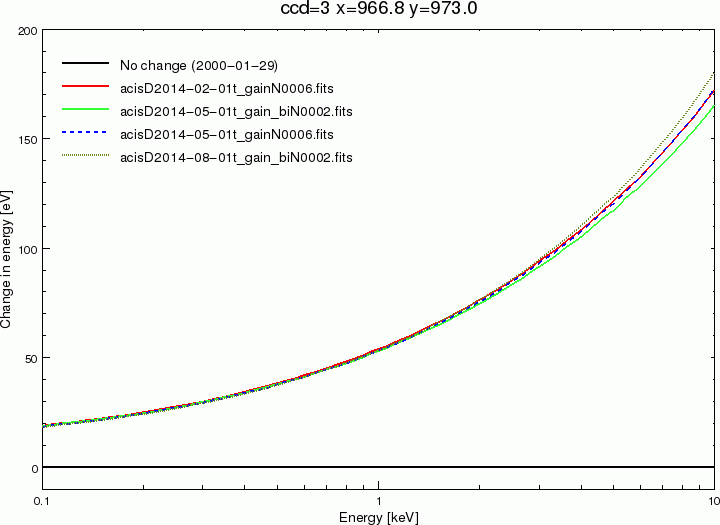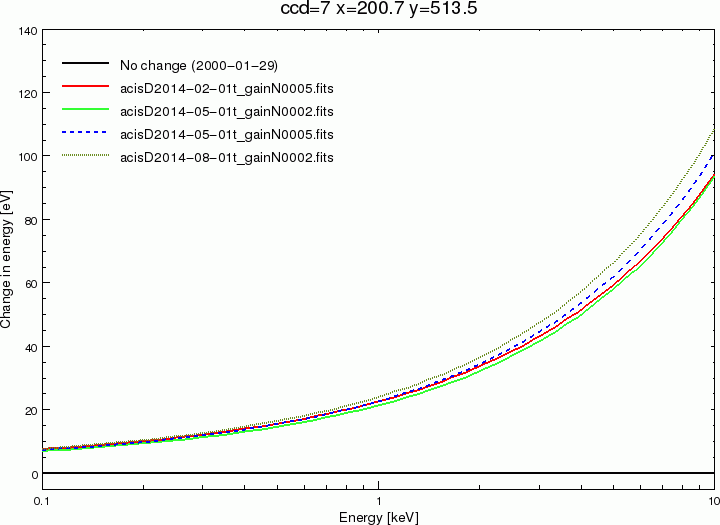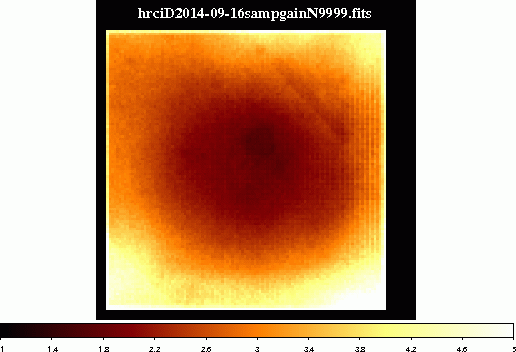CalDB 4.6.5 Public Release Notes
Public Release Date: 16 DEC 2014
SDP Installation Date: 2014-12-16T17:15:00 (UTC)
I. INTRODUCTION
CalDB 4.6.5 is an upgrade to the Chandra CalDB, which includes the following items:
- ACIS T_GAIN EPOCH 59
- ACIS GRADE FILE Version N0005
- ACIS 2009 BKGRND Header Corrections
- HRC-I GMAP and PIBGSPEC 2014 updates
- HRC-S QE and QEU Upgrades
- PIMMS Cycle 17 Effective Areas
For the CIAO 4.7 / CalDB 4.6.5 release notes see How CalDB 4.6.5 Affects Your Analysis.
II. SUMMARY OF CHANGES
A. ACIS T_GAIN EPOCH 59
| Location: | $CALDB/data/chandra/acis/t_gain/ |
| Filenames: | acisD2014-05-01t_gainN0005.fits acisD2014-05-01t_gainN0006.fits acisD2014-08-01t_gain_biN0002.fits acisD2014-08-01t_gainN0002.fits |
The periodic ACIS T_GAIN correction upgrade for Aug-Oct 2014 (Epoch 59) has been released. The corrections are at nominal/expected levels of less than 2% of the energy value. This upgrade as usual affects observation data taken over the two most recent T_GAIN Epochs (59 and 58), and so would update PHAs for OBS_IDs taken since 01 May 2014. Users with such datasets are encouraged to revalidate their analysis results after reprocessing their data with the upgraded CalDB files. For specific details of the new calibrations in this release, see the technical details section below.
See the ACIS T_GAIN why page for more information.
PIPELINES/TOOLS AFFECTED:
DS and CIAO level 1 (re)processing tool acis_process_events
Also: CIAO reprocessing script chandra_repro
THREADS AFFECTED:
Reprocessing Data to Create a New L2 Events File
B. ACIS GRADE FILE Version N0005
| Location: | $CALDB/data/chandra/acis/grade/ |
| Filename: | acisD2009-11-01gradeN0005.fits |
As of the date 2009-11-01, a change in the ACIS parameter block caused the FLT GRADE "66" events to be telemetered for the ACIS CC-mode cases. For the CC-GRADED datamode observations, it has been decided that these events should be mapped to ASCA GRADE "2", and not filtered from the ACIS level 2 events files. A modification of the ACIS GRADE file, to add a special third extension for the ObsIDs with DATAMODE=CC33_GRADED which would allow for that mapping specification.
The new GRADE file above was actually added to Standard Data Processing (SDP) CalDB at the CXC with the Installation of DS 10.3, in CalDB version 4.6.4, which was not released to the public. With the CIAO 4.7 release, the modification necessary to use the new GRADE file extension, already implemented in acis_process_events in DS 10.3, has now been included in the CIAO acis_process_events tool.
PIPELINES/TOOLS AFFECTED:
For ACIS ObsIDs with DATAMODE=CC33_GRADED only!:
DS and CIAO level 1 (re)processing tool acis_process_events
Also: CIAO reprocessing script chandra_repro
THREADS AFFECTED:
For ACIS ObsIDs with DATAMODE=CC33_GRADED only!: Reprocessing Data to Create a New L2 Events File
C. ACIS 2009 BKGRND Header Corrections
| Location: | $CALDB/data/chandra/acis/bkgrnd/ |
| Filenames: | acis0D2009-09-21bgstow_ctiN0001.fits acis0iD2009-09-21bkgrnd_ctiN0002.fits acis1D2009-09-21bgstow_ctiN0001.fits acis1iD2009-09-21bkgrnd_ctiN0002.fits acis2D2009-09-21bgstow_ctiN0001.fits acis2iD2009-09-21bkgrnd_ctiN0002.fits acis2sD2009-09-21bkgrnd_ctiN0002.fits acis3D2009-09-21bgstow_ctiN0001.fits acis3iD2009-09-21bkgrnd_ctiN0002.fits acis3sD2009-09-21bkgrnd_ctiN0002.fits acis5D2009-09-21bgstow_ctiN0001.fits acis5sD2009-09-21bkgrnd_ctiN0002.fits acis5sD2009-09-21bkgrndN0001.fits acis6D2009-09-21bgstow_ctiN0001.fits acis6iD2009-09-21bkgrnd_ctiN0002.fits acis6sD2009-09-21bkgrnd_ctiN0002.fits acis7D2009-09-21bgstow_ctiN0001.fits acis7sD2009-09-21bkgrnd_ctiN0002.fits acis7sD2009-09-21bkgrndN0001.fits acis8sD2009-09-21bkgrnd_ctiN0002.fits acis6sD1999-08-12bkgrndN0002.fits acis7sD1999-08-12bkgrndN0002.fits |
The above files had variances from the standard header for event lists, specifically that the keywords RA_PNT, DEC_PNT, and ROLL_PNT were not set to REAL8 data types, but instead were built with INT4 data types. This variance causes an error in the thread for using the ACIS blank-sky background files, wherein the dmreadpar command does not reset the keyword values in the tailored BKGRND file header. The simple fix is simply to reset the data type for these keywords to REAL8, by deleting them and adding them back with the correct data type. This has been done, and a new acis BKGRND tar ball has been built for CalDB 4.6.5.
PIPELINES/TOOLS AFFECTED:
CIAO Data Model tool dmreadpar.
THREADS AFFECTED:
Analysing the ACIS Background with the "Blank-Sky" Files
D. HRC-I GMAP and PIBGSPEC 2014 updates
| GMAP Location: | $CALDB/data/chandra/hrc/gmap/ |
| Filename: | hrciD2014-09-16sampgainN0001.fits |
| PIGBSPEC Location: | $CALDB/data/chandra/hrc/pigbspec/ |
| Filename: | hrciD2014-09-16pibgspecN0001.fits |
The annual update to the HRC-I time-dependent gain and the corresponding PI Background Spectrum are now available. Technical DETAILS of the new GMAP image are available below.
See the HRC-I Gain Maps why page for more information.
PIPELINES/TOOLS AFFECTED:
GMAP only: hrc_process_events
THREADS AFFECTED:
For the GMAP: Reprocessing Data to Create a New Level=2 Event File
For the PIBGSPEC: The HRC-I Background Spectra Files
E. HRC-S QE and QEU Upgrades
| QE Location: | $CALDB/data/chandra/hrc/qe/ |
| Filenames: | hrcsD1999-07-22qeN0013.fits hrcsD2012-03-29qeN0013.fits |
| QEU Location: | $CALDB/data/chandra/hrc/qeu/ |
| Filenames: | hrcsD1999-01-01qeuN0007.fits hrcsD2000-01-01qeuN0007.fits hrcsD2001-01-01qeuN0007.fits hrcsD2002-01-01qeuN0007.fits hrcsD2003-01-01qeuN0007.fits hrcsD2004-01-01qeuN0007.fits hrcsD2005-01-01qeuN0007.fits hrcsD2006-01-01qeuN0007.fits hrcsD2007-01-01qeuN0007.fits hrcsD2008-01-01qeuN0007.fits hrcsD2009-01-01qeuN0007.fits hrcsD2010-01-01qeuN0007.fits hrcsD2011-01-01qeuN0007.fits hrcsD2012-01-01qeuN0007.fits hrcsD2012-03-29qeuN0007.fits hrcsD2013-01-01qeuN0007.fits hrcsD2014-01-01qeuN0007.fits hrcsD2015-01-01qeuN0007.fits hrcsD2016-01-01qeuN0007.fits hrcsD2017-01-01qeuN0007.fits hrcsD2018-01-01qeuN0007.fits hrcsD2019-01-01qeuN0007.fits hrcsD2020-01-01qeuN0007.fits |
The quantum efficiency and uniformity corrections for the HRC-S are being updated, retroactive to launch date. Hence, the two existing HRC-S QE files (the first covering launch date to the HRC-S HV change effective March 29, 2012, and the second covering the period since then) are both being upgraded with 7% reductions in the short-wavelength QE as described below. Furthermore, the existing annually-spaced QEU files are all being upgraded to version N0007.
The actual changes in the net QE are effective only for wavelengths shorter than that of the Carbon K-edge. This update may be considered an extension of the previous HRC-S QE upgrade (released in CalDB 4.4.7, 15 December 2011) which was a modification to the low-energy calibration only.
The QE Uniformity has been modified to correct for the more substantial QE decline that has occurred in regions of the HRC-S plates where the gain has declined more rapidly than in other more stable regions. The numerous files are necessary to track the overall HRC-S QE decay with time that corresponds to the time-dependent gain decay. Technical DETAILS of the new QE and QEU calibrations are available below.
See the HRC-S QE/QEU why page for more information.
PIPELINES/TOOLS AFFECTED:
The following CIAO tools will be affected by the HRC-S QE/QEU upgrades:
THREADS AFFECTED:
Users of the following threads will be affected by the modifications in the HRC-S QE and QEU:
F. PIMMS Cycle 17 Effective Areas
| Location: | $CALDB/data/chandra/pimms/acis/ |
| Filenames: | acisiD2014-12-04pimmsN0017.fits acisihetg0D2014-12-04pimmsN0017.fits acisiletg0D2014-12-04pimmsN0017.fits acissD2014-12-04pimmsN0017.fits acissheg1D2014-12-04pimmsN0017.fits acisshegmeg1D2014-12-04pimmsN0017.fits acisshetg0D2014-12-04pimmsN0017.fits acissleg1D2014-12-04pimmsN0017.fits acissletg0D2014-12-04pimmsN0017.fits acissmeg1D2014-12-04pimmsN0017.fits |
| Location: | $CALDB/data/chandra/pimms/hrc/ |
| Filenames: | hrciD2014-12-04pimmsN0017.fits hrciletg0D2014-12-04pimmsN0017.fits hrcsD2014-12-04pimmsN0017.fits hrcsleg1D2014-12-04pimmsN0017.fits hrcsleghiD2014-12-04pimmsN0017.fits hrcsletg0D2014-12-04pimmsN0017.fits |
PROPOSAL PLANNING TOOLS AFFECTED:
Cycle 17 PIMMS Count Rate Calculator
Cycle 17 PIMMS Effective area viewer
III. TECHNICAL DETAILS
A. ACIS T_GAIN EPOCH 59
The ACIS time-dependent gain corrections (T_GAIN) have recently been updated for current changes from the previous T_GAIN epoch, specifically Epoch 59, which was Aug-Oct 2014. With the addition of these new corrections, derived from ACIS External Cal Source (ECS) data taken during radiation zone passes, the CalDB files extending from May-Jul 2014 (i.e. Epoch 58) have been finalized, and new non-interpolating T_GAIN files are now implemented for Epoch 59.
The magnitudes (in eV) of the new gain corrections, versus photon energy, are given in Figs. 1-3 below. The corrections are of the usual order in magnitude, specifically less than 2.0% of the photon energy value. Fig. 1 below gives the corrections for the ACIS-I aimpoint on chip ACIS-3, for the CTI-corrected case, which is the only one applicable to FI chips. Figure 2 gives the corrections for the ACIS-S aimpoint on ACIS-7, for the case where the BI chips are CTI-corrected. Finally Fig. 3 gives the corrections for ACIS-7 for NON-CTI-corrected BI chips. These would be relevant to GRADED DATAMODE observations with ACIS-S, for example.

Fig. 1: ACIS-I3 aimpoint T_GAIN corrections in eV versus photon energy.

Fig. 2: ACIS-S3 CTI-corrected aimpoint T_GAIN corrections in eV versus photon energy.

Fig. 3: ACIS-S3 non-CTI-corrected aimpoint T_GAIN corrections in eV versus photon energy.
Long term trends for chips I3 and S3 are plotted below in Figure 4a and b, through Epoch 59, the latest release. The chip locations for these plots are given in the respective labels above the plots. Note that the locations are not the aimpoint positions, as with Figs. 1-3 above, but are near the centers of each chip.
D. HRC-I GMAP and PIBGSPEC 2014 updates
A new HRC-I GMAP has been generated for the (UTC) period 2014-09-16T12:00 to the present, and extending into 2015. The corrections were generated using G21.5-0.9 and HZ 43 calibration observations taken regularly to monitor HRC-I, combined with a sequence of ArLac observations at 21 specific locations on HRC-I, taken annually.
The HRC-I gain continues to decline slowly (typically ≤5% per year). Annual updates to the gain maps are found to be adequate to maintain 2% consistency in the PI. Images of the new Sept 2014 GMAP, and a ratio of the new map to the previous (2013) one already in CalDB are shown in Fig. 5A & B below. In Fig. 5B, the sense of the ratio is that the 2014 map includes equal to or larger corrections (equal to or greater than unity) compared with last year's gmap.

Fig. 5A: The new HRC-I GMAP derived from Sept 2014 ArLac observations, and periodic HZ43 and G21.5-0.9 observations. |

Fig. 5B: Ratio of the new 2014 GMAP to the one from 2013. |
A corresponding upgrade to the PIBGSPEC library fo 2014 has also been derived, effective for the same time-period as the above HRC-I GMAP. The background PI spectra are generated from the same HRC-I calibration observations of AR Lac used to derive the new GMAP. These 21 observations are reprocessed with the new GMAP, generating new PI scaled to SUMAMPS values.
For each year, the HRC-I Cal team extracts events in a 800x800 pixel box at the 17 observation locations that are within 10 arcmin of the aim point, excluding the location of the source. They sum the PI spectra from each location, weighting by exposure time, to create the final PI spectrum for the year. Finally, the PI spectra are Loess-smoothed with a third-degree polynomial fit over ranges 10 channels wide.
Figure 6 shows the PI spectra (as calculated count rates) for several of the PIBGSPEC files from 2000 (black), 2005 (red), 2009 (green), 2010 (blue), 2011 (cyan), 2012 (magenta), 2013 (yellow), and 2014 (orange):

Fig. 6: The HRC-I Background PI spectra for 2000-2014, including the latest
spectrum derived from Sept 2014 AR Lac data.
E. HRC-S QE and QEU Upgrades
Analyses of LETG+HRC-S observations of the hot white dwarf HZ43 have indicated a loss in gain at certain plate locations in both positive and negative spectral orders. A revision to the quantum efficiency uniformity (QEU) map amounting to a few percent at the appropriate detector locations is able to correct both the spectral response of the instrument and an apparent secular trend in the dispersed flux as a function of time. At higher energies, analyses of interleaved series of blazer data with the LETG in combination with both ACIS-S and HRC-S detectors indicate that derived fluxes for the latter are systematically lower than the former. A downward revision of the HRC-S quantum efficiency (QE) by 7% for photon energies above that of the carbon K edge is the current best-guess of the correction required to reconcile derived fluxes.
The LETGS calibration team has used a Continuous Autoregressive Moving Average or CARMA method to reconcile differences in derived fluxes between two blazar sources observed with LETGS and with LETG/ACIS-S (namely Mkn 421 and PKS 2155-304) at wavelengths below (i.e. energies above) the carbon K-edge. We recall here that a similar adjustment was made in the QE model at energies below C-K (284 eV) in the previous average QE upgrade (HRC-S QE version N0011 in CalDB 4.4.7, 15 Dec 2011.) Hence this new upgrade may be seen as an extension of that earlier derivation to higher energies.
The gradual HRC-S gain decline that lead to the decision to raise the high voltage in 2012 occurred fairly uniformly across the detector, but did not have a uniform impact on the quantum efficiency. Areas of the HRC-S plates that had low gain have experienced a palpable decline in their QE sine then, while regions with more healthy gain have not. The revised QEU calibration is designed to take this non-grey gain-related QE decline into account. The problem and its solution are illustrated in Figure 7, which shows the LETG+HRC-S spectrum of HZ 43 obtained in 2014 (ObsID 16375) in the positive spectral order on plate S3 compared with the reference hot white dwarf model atmosphere flux that is the basis of the current low energy LETG+HRC-S effective area calibration. The residuals for the default calibration together with those for the revised QEU file are illustrated.

Fig. 7: Illustration of the flux as a function of wavelength obtained from
ObsID 16365, an LETG+HRC-S observation of HZ 43, in the positive spectral order
compared with the reference model flux. The flux obtained using
the previous QEU (N0006) is shown in black, while data obtained using the corrected QEU (N0007)
are shown in red.
The revised QEU files also account for a secular trend of apparent declin- ing flux of HZ 43 obtained from the dispersed spectra since 2011. The light curves obtained from the use of the default calibration and the revised QEU file are illustrated in Figure 8 below. The corrected QEU files lead to an essentially flat (constant) flux, including epochs immediately before and after the high voltage change.


